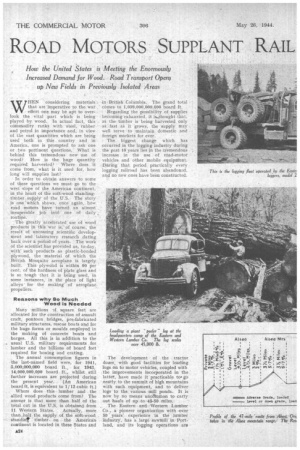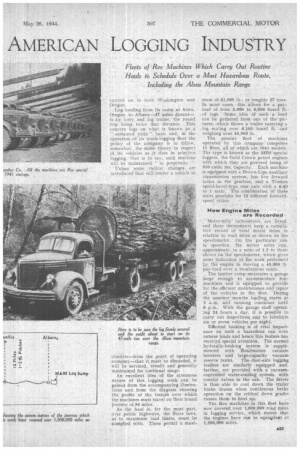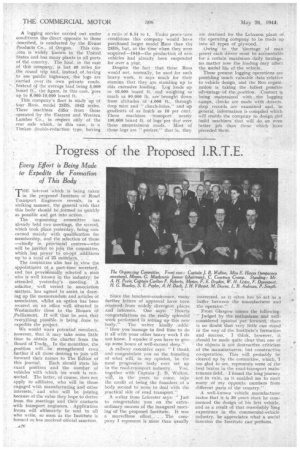ROAD MOTORS SUPPLANT RAIL AMERICAN LOGGING INDUSTRY
Page 26

Page 27

Page 28

If you've noticed an error in this article please click here to report it so we can fix it.
WHEN considering materials that are imperativeto the war effort one may be apt to overlook the vital part which is being played by wood. In actual fact, this cOturriodity ranks with steel, rubber and petrol in importance and, in view of [he vast quantities which are heibg used both in this country "and in America, one is prompted to ask one or two pertinent questions, What is behind this tremendous new use of wood? How is the huge quantity required harvested? Where does it come from, what is it used for how long i.1,,ili supplies last?
In order to obtain answers to some of these questions we mustgo to the west slope of the American continent, in the heart of the Soft-wood sianding . .
timber . supply of the U.S. The story . is one ' which glows, once again, how road motors have turned an almost insuperable . job • into one of daily
routine. • -. The greatly accelerated use of wood products in this war is, of course, the result of unceasing scientific development and laboratory research .dating back over a period of years. The work of the scientist has provided us, to-day, with such products as plastic-bonded plywood, the material of which the British Mosquito aeroplane is largely built, This plywobd is within 90 Per cent: of the hardness of plate glass and is so tough that it is being used, in some instances, in the place of light . alloys., for the making of aeroplane propellers.
Reasons why So Much
. Wood is Needed Many millions -If square feet are allocated for the construction of assault craft, pontoon bridges, pre-fabricated military structures, rescue boats and for the huge forms or moulds employed in the making of concrete boats and barges. All this is in addition to the . usual U.S. military requirements for lumber and the billions of board feet required for boxing and crating.
The annual consumption figures in the last-named field were, for 1941, 5,000,000,000 board ft„ for 1943, 14,000,000,000 board ft., whilst still further increases are projected during the present year. " (An American board ft. is equivalent to 1/12 cubic ft.) Where does this . lumber and the allied wood products come from? The answer is that more than half of the total cut in the U.S. is obtained from 1I Western States. Actually, more than half the supply of the soft-Wood standint " timber on the American continent is locatedin these States and in 'British Columbia. The grand total chines to 1,039,000,000,000 board ft.
Regarding the possibility of supplies becoming exhausted, it is.thought that, a•S the timber is being harvested only at "fast as it grows, the supply may well serve to maintain domestic and foreign markets for ever.
The biggest change which has occurred in the logging industry during the'past. 10 years lies in the tremendous increase in the use of road-motor vehicles and other mobile equipment.
• During that period practically every logging railroad has been abandoned, and no new ones have been constructed.
The development of the tractor dozer, with good facilities for loading logs on to motor vehicles, coupled with the improvements incorporated in the latter, have made it practicable to. go nearly to the sunimit of high mountains with such "equipment, and to deliver logs to the various mill ponds. It is now by no means uncdhamon to carry out hauls of up to 45-50 miles.
, The Eastern . and Western Lumber Co., a pioneer organization with over 50 ',years'. experience in the • lumber
inclu.Stri, has a large sawmill in Port• land, aud its logging operations are carried On in both .Washington and Oregon. „ •
Log hauling from its camp at Alsea, Oregon, to Albany-47 miles distant--i's, by lorry, and :log trailer, the round
• trip being twice that distance. This concern logs 'on what is knowii as a " sustained yield " basis and in the operation,of its truck-logging fleet the policy of the company iS to follow, • somewhat, the •same theory in respect of its vehicles as it does in selective logging, that is to say, each machine will be maintained " in perpetuity.'' 'Unless some radical changes are introduced that will 'render a vehicle so obsolete—from the point of operating economy—that it must he discarded, it will be serviced, 'rebuilt and generally maintained for continual usage. .
An excellent idea of the strenuous nature of this .logging work can he gained from the accompanying illustrations and, from the 'diagram showing the profile of the terrain over which the machines must travel on their round journey oi 94 miles.
As the haul is, for the most part, over public highways, the State laws, as to maximum load Unfits, must be complied with. These permit a maxi mum of 61,000 th., or roughly 27 tons. In most cases, this :silloWS for a payload of frcim .5,000 to 6,000 board , of logs. -Some idea of such a load can 'be gathered from 'one of the pictures, which Shows a trailer .carrying "a log scaling over 6100 board -ft. .and. weighing over. 45,000 lb.
The present fleet of machines operated by this company comprises Il Reos, all of which are' 1941 models.
The type is known .as the 23BS 'special loggers, the Gold Crown petrol engines with which they are powered being of 319 cubic ins. capacity. Each machine is equipped with a Brown-Lipe auxiliary transmission system, has five forward
• ratios in the gearbox, and a Timken spiral-bevel-type rear axle with a 6.80 to 1 ratio. The combination of the:Se 'Units provides for 18 different forWard. speed ratios.
HOW Engin, Miles are Recorded
Motor-miletachometers are fitted, and these instruMents keep a cumula:
tive record of total motor miles in relation to road Miles as Shown on the speedometer. On the 'particular run
in question, the ,motor miles ruti,_ approximate, in a ratio of 1.5-to those shown on the speedometer, which gives some indication of the work performed
the engine in moving a 45,000 lb • pay-idad over a moutainous route.
The lumber camp maintains a garage large enough to accommodate PDT
machines and is equipped to provide for the efficient Maintenance and repair of the vehicles in the fleet. During the summer months loading, starts at 5 am, and running continues Until 6 p.m. With the garage staff operat
ing 24 hours a day, it is pOSsible. to carry out inspections and to lubricate six -or seven vehicles per night.
Efficient braking is of vital importance on such a hazardous run' with Outsize loads and hence This feature has received special attention. The normal hydraulic-braking system is .supple mented with Roadrnaster vacuum
boosters and large-capacity vacuum
reserve tanks. The dual-axle logging trailers are similarly equipped. and, further, are provided with a yatuumcontrolled water-cooling system, with control Valves in the cab. The driver is thus able to cool down the trailer brake drums when continuous brake operation on the critical down grades causes them to heat up.
The .Reo machines in this fleet have now covered 'over 1,000,009 road miles in logging service, which means that the engines have run to equivIent of '1,500,000 miles.
A logging service carried out under conditions thedirect opposite to those described, is conducted by the Evans Products Co., of Oregon. This con.:ern is widely known in the United States and-has many plants in all parts of the country. The haul, in the case of this company, is but 40 miles for the round trip and, instead, of ,having to use -public highways, the logs are carried over its own private roads.
• Instead of the average load being 5,000 hoard ft:, the figure, in this case, goes up to 3,000-10,000 board ft.
This company's fleet is made -up of four Rena, model 23BS, 1942 series. These machines differ from those . operated by the Eastern and Western Lumber Co., in resPect only of the rear axle which, • in this case, is a Timken double-reduction type, having
a ratio of 8.54 to 1. Under peace-time conditions this company would have purchased larger model Reos than the 23ES, but, at the time when they were acquired-1943—the production of new vehicles had already been suspended for over a year.
Despite the fact that these Reos would not, normally, be used for such heavy. work, it. says much for their stamina that they are standing up to this excessive loading. Log loads up to 10,000 board ft. and weighing as much as 90,000 lb. are brought down from altitudes of 4,000 ft., through deep mire and " chuck-holes, '. and up gradients of as Much' as 10 per cent. These machines • transport nearly 100,000 board ft. of logs per day' over these mountainous roads. Most of these logs are " peelers," that "is, they are destined for the Lebanon plant of the operating company to be made up into all types of plywood. •
Owing to the 'shortage of man power each driver must be accountable for-a certain 'maximum daily haulage. no matter now the loading may affect the -useful life. of the vehicle.
These present logging operations are providing much valuable data 'relative to vehicle design, and the Rea organization is taking the fullest possible advantage of the.position. Contact is being maintained with the logging camps, checks are made with drivers, Shop records. are examined and, in general, information is compiled which will enable -the company to design and build machines that will do an even better job than those which have preceded them,




















































